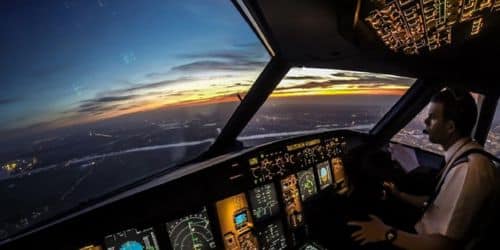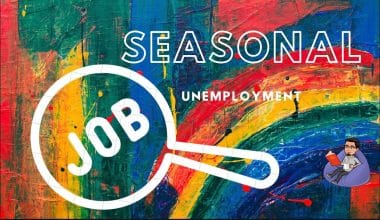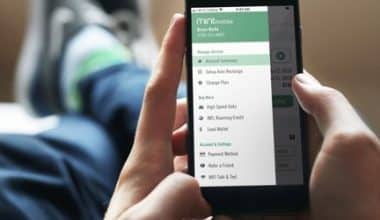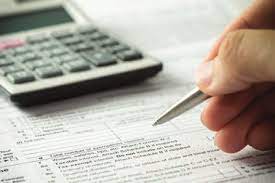An airline pilot captains an airplane that transports people and freight from one location to another. The responsibilities of an airline pilot include performing pre-flight instrument checks, taxiing aircraft to and from airport gates and around runways, handling takeoffs and landings, and flying aircraft safely between destinations. Here’s all you need to know about an airline pilot and how to become one.
What Does an Airline Pilot Do?
An airline pilot is in charge of transporting passengers and other crew members from one location to another. They must use sophisticated technology to navigate the aircraft’s flight path and control all other aspects of the plane’s movement. The captain (pilot in command) and first officer (second in command) work together in the cockpit to ensure a safe flight, from vehicle inspection and flight logs through precise takeoff and landing coordination.
Airline pilots fly multi-engine aircraft, which necessitates extensive technical knowledge. They are in charge of flying the plane through bad weather and dealing with any mechanical issues that arise while in flight. To comprehend their flight route, airline pilots must interact with air traffic controllers and use radar.
What Makes A Good Airline Pilot?
To be a good airline pilot, you must be physically fit enough to do your tasks without endangering passengers or other crew members. To fly commercial aircraft, you must first obtain a Medical Clearance certificate from the Federal Aviation Administration (FAA). In addition to physical fitness, you must be able to remain cool and concentrate in difficult situations, such as bad weather or mechanical problems with your aircraft. Experience flying several types of aircraft can provide you with the necessary abilities to be successful in this field.
Responsibilities and Duties Of An Airline Pilot
- Conduct pre-flight inspections to ensure the aircraft is in safe working order.
- Obey FAA regulations and company policies and procedures.
- Weather trends should be monitored in order to plan the most effective flying paths.
- Maintain contact with air traffic control and other planes.
- Respond as soon as possible to any emergency or unforeseen occurrences.
- Ensure the comfort and safety of the passengers throughout the journey.
- Complete the post-flight inspection and documentation.
Qualifications and Requirements
- Airline Transport Pilot’s License given by the FAA
- Knowledge of aviation legislation and safety procedures is required.
- Outstanding physical and mental health
- Capable of remaining calm and rational under challenging conditions
- Excellent interpersonal and communication abilities
- Capable of working both independently and as part of a team
What Is The Average Salary Of An Airline Pilot?
Pilot salaries, like those of other occupations, are not uniform. Pilot salaries vary annually depending on the airline, the type of aircraft, and even the flight path. Salary, for example, is determined by a variety of factors such as pilot credentials, experience, job title, and pilot union agreements. Furthermore, most people are unaware that pilots are paid by the hour rather than an annual income. According to GlassDoor, a platform where people self-report their incomes, average domestic airline pilot salaries are reasonable. However, salaries differ between airlines.
Southwest Airlines pilots, for example, earn an average yearly compensation of $222,000. Some Southwest pilots, on the other hand, earn up to $549,000. Similarly, United Airlines pilots receive an average salary of $205,000 per year. Delta Airlines pilots make an average of $192,000 per year, with top earners earning $526,000. American Airlines pilots make an average of $118,000 per year, with some making more than $700,000. Most critically, pilot pay continues to rise. Even multinational airlines offer competitive salaries. Qatar pilots, for example, earn an average of $173-187,000 per year. Furthermore, China Southern Airlines pays its pilots a starting salary of $228,000 per year. The average Lufthansa pilot makes $102,000 per year.
How to Become an Airline Pilot
To become an airline pilot, follow these procedures to finish the necessary training and accumulate experience:
#1. Earn a bachelor’s degree that has been approved by the FAA.
When applying for jobs as an airline pilot, most major airlines require a bachelor’s degree in aviation or a related field. If you want to be an airline pilot, the most frequent step students take is to enroll in an FAA-approved college and study aviation-related coursework to get a degree while also receiving pilot training.
This path can help you get closer to your ultimate goal of becoming an airline pilot. The pilot training that is normally included as part of an FAA-approved college or university’s aviation program is a significant benefit. They can provide students a wider range of training tools, dedicated facilities, and greater scheduling flexibility for flight hours.
#2. Get a private pilot’s license.
To obtain a private pilot certificate or license, you must first study basic flight techniques, aircraft movements, navigation, flight planning, and emergency training. You can legally fly a plane if you hold this certification. Pilots who gain this qualification learn to fly small planes on their own.
#3. Obtain an instrument rating.
Flying for an airline necessitates the ability to read and use instruments. After earning your basic pilot’s license, you’ll need to learn how to operate sophisticated equipment that guides a plane through various weather conditions and heights. This qualification teaches pilots how to communicate with air traffic control and the National Airspace System.
#4. Get a commercial pilot’s license.
A commercial pilot license permits pilots to make money by flying goods or passengers. With this certification, a pilot can work in search and rescue, passenger flights (such as tourism or business), and freight deliveries. A pilot in this category receives further training to get ratings for each class of airplane they wish to fly. For example, they can supplement their single-engine commercial pilot license with a multi-engine rating.
#5. Obtain a certificate as a flight instructor.
Many pilots seek to become flight teachers in order to obtain experience and flight hours. Pilots can earn a living while logging hours. Most airlines demand a certain number of flying hours before applying to be a first officer. Working as a flight teacher is a good method to get the flight hours and experience you need to become an airline pilot.
#6. Include a multi-engine rating.
Pilots must gain an additional rating to their commercial license in order to fly the planes used by passenger carriers. Pilots must demonstrate their ability to pilot huge planes with several engines. This certification training entails studying what to do in the event of a single-engine failure as well as handling these enormous planes in all areas of flight.
#7. Gain flight hours and experience
To become an airline pilot, you must accumulate a large number of flight hours. The FAA specifies a total flight hour requirement of 1,500. This can be accomplished through training classes, flight instruction, and employment as a commercial pilot.
#8. Earn your airline transport pilot license.
The FAA’s highest level of licensure is airline transport pilot (ATP). Pilots must have more than 1,500 hours of flying experience to obtain this certification. Pilots must also have logged particular flight hours, such as pilot in command (PIC), night flying, and cross-country PIC.
Prospective airline pilots must also complete medical exams in order to obtain an ATP certification. To act as a pilot in command, pilots must pass a first-class medical exam and a second-class medical exam.
#9. Interview for an airline pilot post
Once you have met all of the FAA requirements, you can apply for a job with a major airline. Because airlines are based on seniority, you will begin as a first officer and progress to captain after at least two years of service.
What is the best route to becoming an airline pilot?
To become an airline pilot, you might pursue a variety of school and training options. The four most common career routes are as follows:
#1. Learn to fly in a flight school.
A Part 61 or Part 141 flight school, which refers to the amount of FAA regulation, will provide the basic flight and navigation instruction you’ll need. These aviation schools frequently provide flexible programs with varying paces and schedules. A Part 141 school, on the other hand, has a strictly regulated instruction procedure, whereas a Part 61 training program can be more flexible in its techniques.
#2. Earn a college diploma from an FAA-approved aviation program.
An aviation college will provide training in addition to a bachelor’s or associate’s degree program. In addition to coursework in aviation-related subjects, you will receive practical training in flight mechanics, piloting, and navigation as part of your education.
#3. Participate in an airline cadet program.
Specialized training for airline pilots is also provided by aviation academies. They are frequently associated with a particular airline and provide a streamlined career path to work for the company. Following an initial training period, those who train with the academy may be required to fulfill specific roles within the airline or an affiliated airline before being automatically promoted to the position of airline pilot.
#4. Join the armed forces.
Some people choose to become pilots because they have the opportunity to serve in the military. Each component of the United States armed forces, including the Army and the Air Force, has its own aviation unit to train pilots. The Marine Corps has the most comprehensive pilot training program. For commissioned officers, the Navy, Marine Corps, and Coast Guard all have naval aviator programs.
Training is paid for in this course due to your military service and long-term commitment. Pilots who train in the military gain a higher level of precision in tactical and emergency reaction. Candidates with past military flying experience are often highly valued by airline programs.
Airline Pilot vs. Commercial Pilot
There are many different types of pilots out there. Some fly for fun, while others fly for a living. Commercial and airline pilots are both professional aviators, yet they work in quite different environments. Commercial pilots are all airline pilots, however not all airline pilots are commercial pilots. What are the distinctions between these two?
When comparing a commercial pilot to an airline pilot, there are various work prospects, minimum hours, and responsibilities associated with each. Let’s get started.
Commercial Pilot
You fly for pay as a commercial pilot, but not for a scheduled airliner.
Employment Prospects
Commercial pilot jobs include flight instruction, being a jump pilot, charter pilot, air ambulance pilot, agricultural pilot, and banner towing pilot. Some of these occupations need a varied number of hours each week.
Hours Required
Pilots must complete 250 hours of flight time for part 61 and 190 hours for part 141 training to acquire their commercial license, but some occupations may require more hours. As an example:
- Flight instructors must complete 10 to 25 hours of training to obtain their flight instructor credential.
- Charter pilots must have at least 500 hours of flight time, depending on the aircraft.
- Air ambulance pilots may need 500 hours of flight time.
Let’s have a look at the responsibilities of these various roles.
Job Responsibilities
Each of these commercial pilot jobs is distinctive in its own way.
Flight training
A flight teacher is in charge of teaching students how to fly. You’ll be passing on your knowledge to student pilots during their flight training adventure in this capacity.
The jump pilot
Skydiving aircraft are piloted by jump pilots. For people interested in skydiving, this career can be both demanding and rewarding.
Pilot chartering
A charter pilot works for a charter airline, flying paying passengers. These pilots typically fly short distances on tiny planes.
Air ambulance pilot
Air ambulance pilots use aircraft to transport organs or patients from one location to another for treatment. Many pilots in this position are on-call for their shifts.
Agricultural test pilot
Agricultural pilots carry out tasks associated with the farming industry. They will be responsible for planting seeds, crop dusting, and hauling feed, among other things.
As a banner tow pilot, you will fly short distances hauling banners. This entails flying low and slowly to highlight the banner you’re hauling, whether for advertising or other objectives.
Airline Pilot
There are numerous differences between an airline transport pilot and a commercial pilot.
Employment Possibilities
With an ATP, you can fly for regional and big airlines, as well as work as a law enforcement pilot, corporate pilot, cargo pilot, firefighting pilot, media pilot, air tour pilot, and government service pilot, among other things. Each role has different hour needs.
Hours Required
While earning your commercial license requires 250 hours of flight time for part 61 and 190 hours for part 141, becoming an airline pilot requires 1,500 flight hours for your airline transport pilot (ATP) license or 1,000 flight hours for your restricted ATP (R-ATP). To get the ATP, military pilots must accumulate 750 hours of flight time and 200 cross-country flight hours. Certain airline jobs require varying levels of experience, but all require an ATP license.
Captains of major airlines must have 1,000 hours of flight time.
Cargo pilots require around 3,000 hours of flight time.
Job Responsibilities
If you want to become an airline pilot, you must first grasp the duties of the role.
Regional Pilots
Regional pilots fly for scheduled airlines, transporting both passengers and freight. SkyWest Airlines, a partner of AeroGuard and the largest regional carrier in the United States, is well-known for its professionalism. Regional airlines often operate on shorter routes using smaller Regional Jet planes such as the ERJ and CRJ. The big carrier partners often brand them.
Pilots from major airlines
Scheduled airliners are likewise flown by major airline pilots, but for longer distances and with more passengers. As a commercial airline pilot, you’ll fly anything from Airbus A319s to Boeing 747s.
Law enforcement Pilots
Police and other aviation groups employ law enforcement pilots. Search-and-rescue and patrolling are responsibilities.
Corporate aviators
Corporate pilots fly private business aircraft and are certified in a variety of aircraft types.
Firefighter Pilots
Firefighter pilots, sometimes known as airborne firefighters, are in charge of putting out flames, transporting crews, and administering water. To fight flames, they’ll fly into locations only accessible by plane.
Air tour Pilots
Air tour pilots are comparable to tour guides, but their perspective is from above. This is a fantastic sightseeing work.
Pilot programs for government services
Pilots in the government service serve for state departments of aeronautics, transportation, or other agencies.
Though it is typical to confuse the differences between a commercial pilot and an airline pilot, you should be able to separate the two now that you have more knowledge about the career prospects, hour requirements for those jobs, and work obligations of each type of pilot.
How Long Does It Take To Become An Airline Pilot?
It takes two months to learn to fly and obtain your private pilot certificate. It takes two years to accumulate the minimum 1,500 hours of flight experience to become an airline pilot.
Is an Airline Pilot Career Worth It?
A career as a pilot is an excellent choice. It’s diverse, entertaining, and exciting. According to Glassdoor.com, the average annual salary for a pilot is $106,627. It’s a place where you’ll never stop learning, and there are several opportunities to diversify within the business.
Do Airline Pilots Need A Degree?
No, you do not need a degree to work as a pilot, however having one will assist you advance your career at most levels, especially when it comes to landing a job with a large airline.
What Is The Divorce Rate For Pilots?
According to research of several professions, pilots have a divorce rate of 30.5%.
Do You Need 20/20 Vision to Be a Pilot?
To hold a first or second-class medical certificate, a pilot’s far vision must be 20/20 or better, with or without correction, in EACH eye individually. Near visual acuity (16′′) is defined as 20/40 in each eye individually.
To summarize,
Whether you already have a private pilot certificate or are looking into it, being an airline pilot necessitates a number of levels of certification and flying training before you can apply for a position with a regional or commercial airline. In this article, we explain the Federal Aviation Administration’s (FAA) standards for becoming an airline pilot and provide step-by-step information regarding a professional pilot’s career.
Related Articles
- HOW TO BECOME AN AIRLINE PILOT: US Career Practices (Steps &Requirements)
- PILOT SALARY: Commercial, International Pilot & What You Need to Know
- AIRLINE PILOT REQUIREMENTS: Complete Guide on How to Become One
- WHAT DAY ARE FLIGHTS CHEAPEST TO BOOK? All You Need To Know






